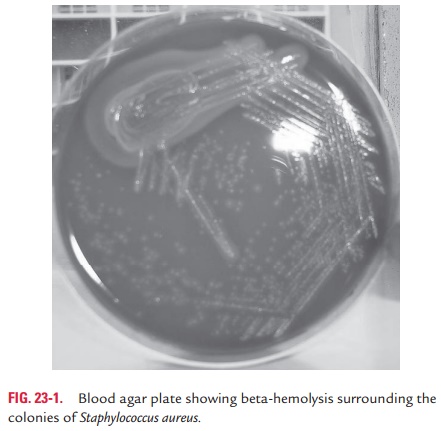Chapter: Microbiology and Immunology: Bacteriology: Staphylococcus
Properties of the Bacteria - Staphylococcus aureus
Staphylococcus aureus
S. aureus is an important human pathogen that causes a spec-trum of clinical diseases. These range from superficial skin lesions like folliculitis to deep-seated abscess and various pyogenic infections like endocarditis, osteomyelitis, etc. The bacterium also causes toxin-mediated diseases, such as food poisoning, toxic shock syndrome (TSS), and staphylococcal scalded skin syndrome (SSSS).
Properties of the Bacteria
◗ Morphology
Staphylococci show following features:
· They are Gram-positive cocci, measuring around 1mm in diameter.
· They are nonmotile, nonsporing.
· They are noncapsulated. They, however, contain a microcapsule, which can be visualized by electron micro- scope only, but not by a light microscope.
The cocci are typically arranged in irregular grape-like clusters. This appearance is due to incomplete separation of daughter cells during successive divisions of bacteria, which takes place in perpendicular planes. The grape-like clustering is seen when the bacteria are grown in solid media, but usually short chains are seen when grown in liquid media.
In smears taken from pus, the cocci are present either singly or in pairs, in clusters, or in short chains of three or four cells.
◗ Culture
Staphylococci are aerobes and facultative anaerobes but can grow in the absence of oxygen also. They grow at a tempera-ture range of 10–42°C (optimum temperature 37°C) and a pH range of 7.4–7.6 (optimum pH 7).
Culture on solid media: Staphylococci can grow on a widerange of media including Mueller–Hinton agar, nutrient agar, blood agar, and MacConkey agar. Primary isolation can be made on nutrient agar and blood agar.
1. Nutrient agar: S. aureusproduces round, convex, well-defined colonies measuring 2–4 mm in diameter. The colo-nies show a butyrous consistency with a smooth glistening surface.
S. aureus produces characteristic golden-yellow coloniesdue to production of a nondiffusible golden-yellow pig-ment. The pigment is believed to be a lipoprotein allied to carotene. The production of the pigment is enhanced by incubation at 22°C in the presence of oxygen. Milk agar and 1% glycerol monoacetate agar are other media that facilitate the production of pigment. On nutrient agar slopes, the growth gives a characteristic “oil paint” appearance.
2. Blood agar: S. aureusproduces a clear zone of hemoly-sis (beta-hemolysis) surrounding the colonies (Fig. 23-1, Color Photo 12). Hemolysis is well marked on sheep or rabbit blood agar, especially when incubated in an atmo-sphere of 20–25% CO2. Sheep blood agar is used for pri-mary isolation.

Hemolysis is weak on horse blood agar. Human blood is not used, as it may contain antibiotics or other inhibi-tors. Other species ofStaphylococcus do not produce hemolysis.
3. MacConkey agar: S. aureusproduces small pink coloniesdue to fermentation of lactose.
4.Selective media: Mannitol salt agar, milk agar, andglycerol monoacetate agar are the commonly used selec-tive media for isolation of S. aureus from clinical specimens containing normal bacterial flora (e.g., stools). Mannitol salt agar contains 1% mannitol, 7.5% sodium chloride, and 0.0025% phenol red indicator. Most strains of S. aureus fer-ment mannitol with acid production, which gives rise to yellow zone formation around the colonies.
Culture in liquid media: S. aureusproduces turbidity in liquidmedia and there is no production of pigment.
◗ Biochemical reactions
S. aureus shows following reactions:
· It is coagulase positive. The production of coagulase is used as a test to differentiate S. aureus from S. epidermidis and other CONS.
· It is phosphatase positive. Phosphatase production can also be used to differentiate S. aureus from S. epidermidis, as the latter either does not produce or has very weak phosphatase activity.
· It is catalase positive. It produces enzyme catalase (unlike Streptococcus), which degrades H2O2into nascent oxygen andwater.
· It is oxidase negative.
· S. aureus ferments mannitol, sucrose, maltose, and trehaloseunder aerobic conditions, with the production of acid but no gas. Fermentation of mannitol is of diagnostic impor-tance, because most strains of S. aureus ferment manni-tol while those of S. epidermidis and S. saprophyticus do not ferment mannitol.
· It liquefies gelatin, hydrolyzes urea, reduces nitrate to nitrite, and is “Voges-Proskauer (VP)” and “methyl red (MR)” posi-tive but indole negative.
◗ Other properties
Susceptibility to physical and chemical agents: The cocciwithstand moist heat at 60°C for 30 minutes but are killed after 30 minutes. They are also killed rapidly by disinfectants, such as phenol, chlorhexidine, and hexachlorophene. The cocci are very sensitive to aniline dyes, such as crystal violet. The dye at a concentration of 1:500,000 inhibits the growth of the cocci on blood agar medium but permits the growth of streptococci.
Related Topics